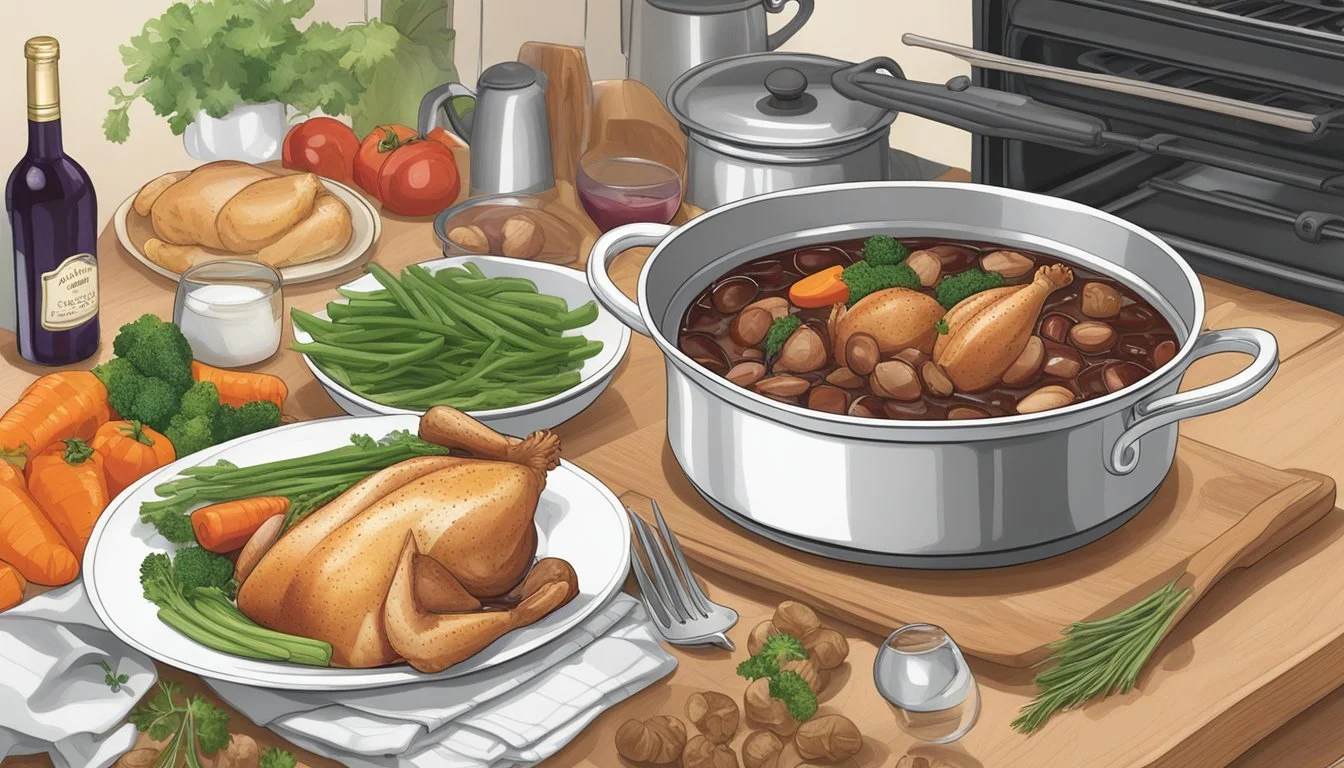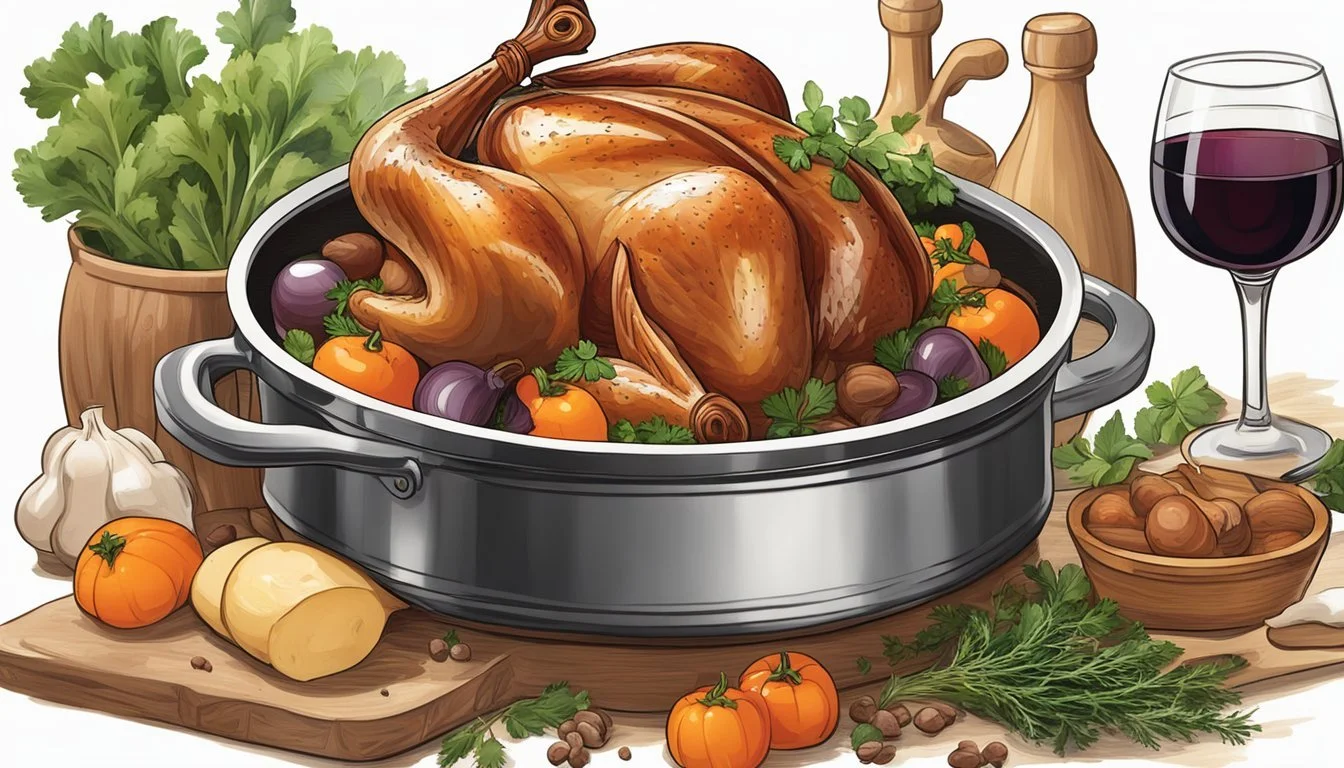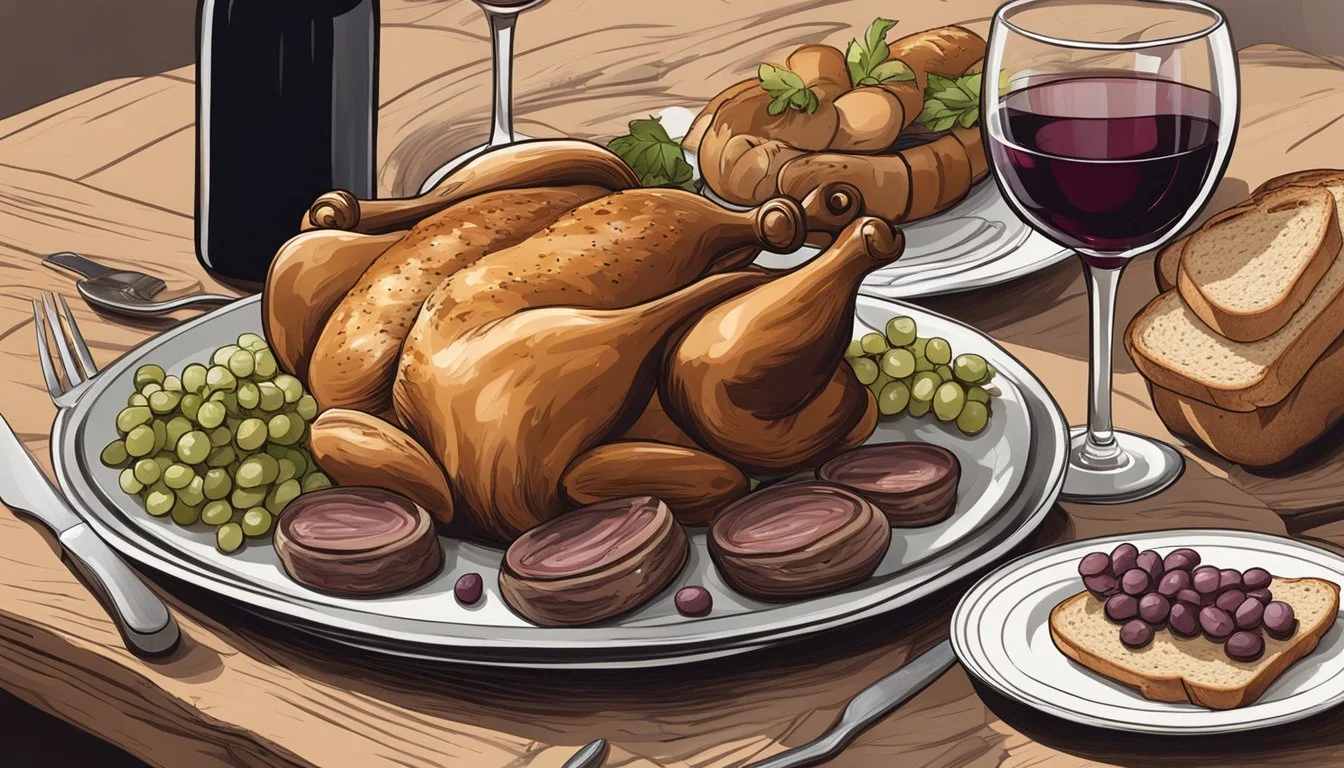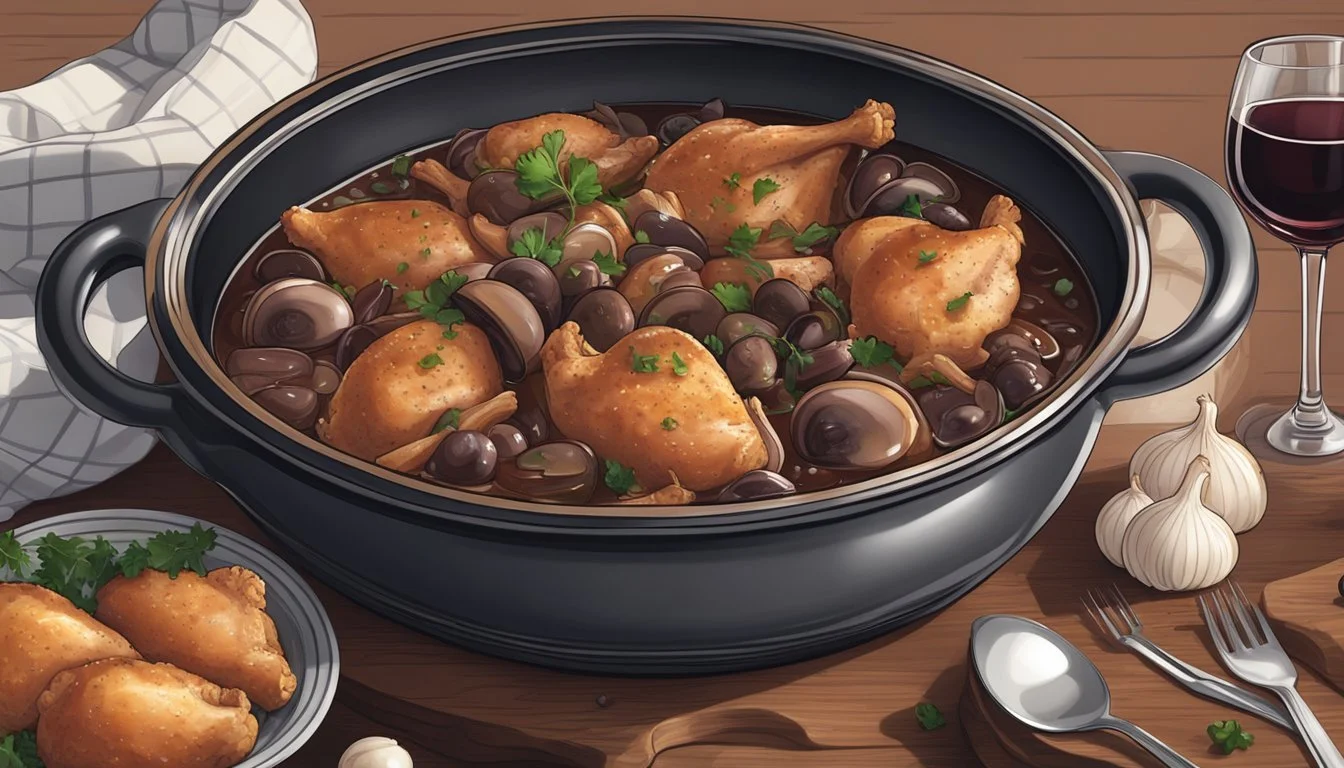Is Coq au Vin Gluten-Free?
Unveiling the Truth About This Classic Dish
Coq au Vin is a classic French dish that translates to "rooster with wine." It is a hearty stew that often includes chicken, slowly cooked in red wine with mushrooms, bacon or pancetta, onions, garlic, and sometimes carrots. The rich flavor of Coq au Vin comes from its time-honored preparation and the depth added by simmering in a full-bodied wine, typically a Burgundy. As a traditional recipe, it captures the essence of French culinary artistry, showcasing how a few quality ingredients can harmonize to create a memorable meal.
When it comes to whether Coq au Vin is gluten-free, the answer largely depends on preparation methods and the specific ingredients used. Gluten is a protein found in wheat, barley, and rye, and their derivatives, which can be present in flour typically used to thicken the stew or in stock that may contain gluten as an additive. Individuals with celiac disease or gluten sensitivity must carefully examine each ingredient to ensure it complies with a gluten-free diet.
Fortunately, making Coq au Vin gluten-free can be a simple adjustment. Instead of using traditional flour to thicken the sauce, one can utilize gluten-free alternatives such as cornstarch or gluten-free flour blends. By carefully selecting gluten-free stock and avoiding any cross-contamination, Coq au Vin can indeed be tailored to fit a gluten-free lifestyle without compromising its authentic French flavor.
What is Coq au Vin?
Coq au Vin is a revered French dish known for its rich and savory flavors. Originating from French cuisine, the name translates to "rooster in wine" and traditionally involves braising a chicken in red wine along with various herbs, garlic, onions, and sometimes mushrooms and bacon.
The dish is a staple in French recipe books and often regarded as a quintessential example of French comfort food. It is characterized by a deep, complex, and warming flavor profile that's achieved through slow cooking. The main ingredient, usually a whole chicken or chicken pieces, is first seared to a golden brown and then simmered in a robust red wine sauce.
Key Elements of Coq au Vin:
Protein: Chicken (historically a rooster)
Wine: Red wine, typically from the Burgundy region
Vegetables: Garlic, onions, and often carrots and mushrooms
Herbs: Commonly thyme, parsley, and bay leaf
Pork Element: Traditionally includes lardons or bacon
Thickening Agent: Sometimes flour for roux
This French recipe is not only part of the nation's culinary heritage but has also gained international acclaim. Chefs and home cooks alike praise it for its comforting essence and the way it showcases the flavors of its ingredients. Despite its seemingly elaborate preparation, it is a dish that lends itself to interpretation and adaptation, with variations that can cater to different dietary restrictions, such as gluten-free versions.
Ingredients in Traditional Coq au Vin
Traditional Coq au Vin features a rich blend of ingredients designed to marry flavors over a slow-cooking process. This French stew is notable for its use of wine and a variety of herbs to create a savory, aromatic dish.
Meat Choices
Chicken: The main protein in Coq au Vin is chicken, typically a whole cut into pieces or chicken thighs (What wine goes well with chicken thighs?) for their tenderness and flavor.
Bacon: Smoked bacon, cut into small strips or lardons, is used to add depth and a smokey undertone to the dish.
Vegetables and Herbs
Onion and Garlic: Essential aromatic base vegetables include onion, finely chopped, and garlic, minced.
Mushrooms and Pearl Onions: Mushrooms, often quartered, and pearl onions are added for their texture and subtle sweetness.
Carrot: Sliced carrots contribute to the stew's hearty quality and add a touch of natural sweetness.
Potatoes: Although not a classic ingredient in every recipe, some variations include potatoes for additional substance.
Liquid Components
Wine: Red wine, traditionally Burgundy, is crucial for its rich flavor and color; it's the stew's liquid base.
Chicken Stock: Chicken stock is used to enhance the poultry flavor and helps to maintain moisture.
Seasonings and Flavors
Thyme and Bay Leaf: Fresh thyme and bay leaf are staple herbs, providing aromatic notes that are quintessential to the stew.
Parsley: Parsley often serves as a garnish, adding a fresh taste and a pop of color just before serving.
Tomato Paste: A small amount of tomato paste can be used to thicken the sauce and provide a subtle tanginess.
Gluten in Coq au Vin
Traditional Coq au Vin may contain gluten through the use of flour as a thickening agent. However, gluten-free adaptations are possible and can retain the dish's authentic flavor.
Identifying Sources of Gluten
Gluten in Coq au Vin can primarily be found in the thickening agents, such as roux, which is a mixture of all-purpose flour and fat, traditionally used to enrich stews (What wine goes well with stews?) and give them a robust body. Additionally, beurre manié, a dough made of equal parts flour and butter, might also be used for thickening, further introducing gluten into the dish.
Gluten-Free Alternatives
When seeking gluten-free options for Coq au Vin, one can substitute traditional wheat-based flour with gluten-free alternatives. Cornstarch is a popular choice that works efficiently to thicken sauces without gluten. It's imperative, though, to mix cornstarch with a cold liquid before introducing it to the dish to prevent clumping. Gluten-free flours, such as rice, chickpea, or certified gluten-free blends, can serve as direct replacements for all-purpose flour to create a roux or beurre manié without the presence of gluten.
Preparation Methods
The essence of coq au vin lies in its slow cooking, which melds the flavors together in a rich, hearty dish. Traditional methods rely on the deep flavors developed from using a Dutch oven for even cooking, while gluten-free modifications swap standard ingredients for gluten-free alternatives without sacrificing taste or authenticity.
Traditional Cooking Techniques
Coq au vin, a French stew, traditionally involves sautéeing chicken with lardons (small strips or cubes of pork fat) until browned. A Dutch oven is commonly used for this step due to its ability to retain and distribute heat evenly, making it ideal for browning meat and vegetables. After sautéeing, one would deglaze the pan with wine, adding a depth of flavor by lifting the browned bits from the bottom of the pan. A bouquet of herbs, such as thyme and bay leaf, is added along with stock, and the dish is left to simmer. The process is slow, often taking upwards of an hour on the stove or in an oven to allow the chicken to become tender and absorb the flavors.
Gluten-Free Adjustments
When adapting coq au vin to be gluten-free, one must replace any gluten-containing ingredient with a gluten-free option. The primary concern is the thickening agent; traditional coq au vin recipes may use flour to thicken the sauce, which is not suitable for those with gluten intolerance. Instead, gluten-free thickeners such as cornstarch or a gluten-free flour blend can be used. All other ingredients, such as bacon, onion, garlic, wine, and stock, are naturally gluten-free, but it is important to check labels, as some stocks and wines may contain gluten due to added flavorings or cross-contamination during processing. A Dutch oven can still be used for gluten-free coq au vin, or one could opt for a slow cooker, which maintains a steady low temperature and is excellent for long, slow simmering that brings out the flavors while ensuring the dish remains warm for serving.
Serving and Pairing Suggestions
Coq au Vin, a classic French dish rich in flavor, is a delight to the senses when served with the right sides and paired with the perfect wine. The following suggestions aim to enhance the dining experience by complementing the dish's deep, savory notes.
Accompaniments
Fresh Parsley: A sprinkle of fresh parsley not just adds a splash of color but also introduces a fresh, herbaceous note to the dish.
Rice: White rice or a buttery risotto makes a neutral base that absorbs the Coq au Vin's robust sauce, allowing its flavors to shine.
Mashed Potatoes: Creamy mashed potatoes are an ideal counterpart, offering a smooth texture that contrasts with the dish's complexity.
Pasta: A simple pasta, such as pappardelle or tagliatelle, serves as a hearty accompaniment, holding the sauce well.
Wine Pairings
Pinot Noir: This wine with its earthy undertones and light to medium body complements the chicken without overwhelming it.
Cabernet Sauvignon: For a bolder choice, a Cabernet Sauvignon offers a robust profile that stands up to the rich sauce.
Presentation Tips
Serve in a beautiful earthenware dish or a cast iron pot to retain heat and add to the rustic charm of the meal.
Garnish with herbs like parsley for a touch of color, making the presentation as appealing as the taste.
Common Challenges and Solutions
When preparing Coq au Vin, a traditional French dish, those adhering to a gluten-free diet often face certain challenges. This section outlines these challenges and proposes clear solutions.
Challenge 1: Traditional recipes call for flour to thicken the sauce, which contains gluten.
Solution: Opt for gluten-free flour blends or thickeners like cornstarch or arrowroot powder.
Challenge 2: Many store-bought stocks and broths contain hidden gluten. Solution: Always check labels or make your own broth from scratch to ensure it's gluten-free.
Challenge 3: Certain wines may have gluten due to the fining process. Solution: They should seek out certified gluten-free wines or check with manufacturers about their fining agents.
Ingredient Substitutions:
Replace wheat flour with a gluten-free flour blend for dusting the chicken.
Use a gluten-free broth or homemade stock to ensure purity.
Select a gluten-free wine; certain wines are safe for gluten-sensitive individuals but checking is important.
Technique Adjustments:
When deglazing the pan, ensure the wine used is gluten-free.
For simmering the ingredients, one must cover and maintain a consistent heat while avoiding potential cross-contamination.
Kitchen Tips:
Chefs should thoroughly clean kitchen surfaces and tools to avoid gluten residues.
Food bloggers recommend labeling gluten-free items in the kitchen to prevent mix-ups.
Through careful selection of ingredients and mindful kitchen practices, Coq au Vin can be a delightful gluten-free dish. It allows those with dietary restrictions to enjoy this classic with confidence and without compromise.
Storing and Reusing Leftovers
When it comes to storing leftovers of Coq au Vin, it's important to handle them properly to maintain their quality and ensure food safety. Leftovers should be cooled to room temperature before being placed in the refrigerator. This should be done within two hours of cooking to prevent bacterial growth. Store the Coq au Vin in a shallow airtight container to speed up the cooling process and protect the flavor. Leftovers can be refrigerated for up to 3-4 days.
For freezing, one should portion out the Coq au Vin into freezer-safe containers or bags. To extend its quality, ensure all air is removed from the bags before sealing. Label the containers with the date, and use them within 3 months for the best taste and texture.
Method: To reheat, one can use a microwave or stovetop. For the stovetop, place the leftovers in a saucepan over medium heat until thoroughly warmed.
Time: Ensure the internal temperature reaches 165°F, as recommended by food safety guidelines.
Tip: Add a splash of water or chicken stock to keep the Coq au Vin moist if it appears dry.
Salads: Chilled Coq au Vin can be shredded and added to summer salads for a beautiful, flavorful protein boost.
Sandwiches: Create a gourmet sandwich by layering shredded Coq au Vin with complementary condiments and greens.
By following these storage and reheating tips, leftovers can be enjoyed safely and can even become the base for new and inviting dishes.
Additional Tips for Gluten-Free Cooking
When preparing gluten-free dishes such as Coq au Vin, a cherished comfort food, meticulous attention to detail is essential to ensure the integrity of the meal.
Ingredients
Broths and Stocks: They often contain hidden gluten. Always opt for certified gluten-free chicken stock.
Wine: Confirm that the wine used for deglazing is free from gluten-containing flavorings or colorings.
Thickeners: Instead of traditional flour, use cornstarch or arrowroot to thicken sauces.
Preparation
Cross-contamination: Use clean surfaces, utensils, and pans to avoid contact with gluten. This is crucial in kitchens where gluten-containing products are also prepared.
Spices: Single-ingredient spices are generally gluten-free, but always check for any gluten-containing additives. Blended spices should be certified gluten-free to avoid risks.
Cooking Techniques
Browning: For a rich flavor, brown the chicken pieces in a separate pan first using gluten-free oil.
Simmering: Slowly simmer the dish with all ingredients, allowing the spices and herbs to infuse the meal and enhance the flavors without the need for flour.
Substitution
Binding Agents: If a recipe requires breadcrumbs, opt for a gluten-free alternative like crushed rice crackers or certified gluten-free breadcrumbs.
By incorporating these practices into your gluten-free cooking routine, one ensures that dishes like gluten-free Coq au Vin are safe and enjoyable for all, without compromising on taste or texture.
Conclusion
Coq au Vin is a classic French dish with deep roots in the culinary world. Traditionally, it incorporates chicken braised with wine, lardons, mushrooms, and sometimes garlic. A standard rendition of this French cuisine highlight is not inherently gluten-free due to the use of flour for thickening sauces or browning the chicken.
For those following a gluten-free diet, alternatives such as gluten-free flour or cornstarch are useful for thickening. One must also ensure that all other ingredients, such as stock and wine, are free of gluten-containing additives.
Here are the key steps to adapting Coq au Vin to a gluten-free version:
Browning: Use gluten-free flour or skip flouring entirely.
Cooking liquid: Confirm that the wine and stock are gluten-free.
Thickening: Opt for cornstarch or a gluten-free flour blend.
When preparing Coq au Vin with these modifications, there's no need to compromise on taste or authenticity. Home cooks and chefs alike can deliver this storied dish, remaining faithful to its French origins while being accessible to those with gluten sensitivities or celiac disease.










